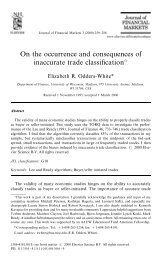A generic framework for Arabic to English machine ... - Acsu Buffalo
A generic framework for Arabic to English machine ... - Acsu Buffalo
A generic framework for Arabic to English machine ... - Acsu Buffalo
You also want an ePaper? Increase the reach of your titles
YUMPU automatically turns print PDFs into web optimized ePapers that Google loves.
2.1. CHARACTERISTICS OF THE ARABIC LANGUAGE<br />
like ‘go’ yd ¯ hb and d ¯ hb ∗ can easily be seen as being part of a hierarchy<br />
of inheritance from a ‘specific root (in this case d ¯ hb). In <strong>English</strong> and in many<br />
other languages this is not usually the case. The <strong>Arabic</strong> language is written from right<br />
<strong>to</strong> left. It has 28 letters, many language specific grammar rules with a relatively free<br />
word order language. Each <strong>Arabic</strong> letter represents a specific sound so the spelling of<br />
words can easily be done phonetically. There is no use of silent letters as in <strong>English</strong>.<br />
Similarly, there is no need <strong>to</strong> combine letters in <strong>Arabic</strong> <strong>to</strong> indicate a certain sound. For<br />
example, the ’th’ sound in <strong>English</strong> as in the word ’Thinking’ is reduced in <strong>Arabic</strong> <strong>to</strong> the<br />
character t ¯ . In addition <strong>to</strong> the standard challenges involved in developing an efficient<br />
translation <strong>to</strong>ol from <strong>Arabic</strong> <strong>to</strong> <strong>English</strong>, the relatively free word order nature of <strong>Arabic</strong><br />
creates an obstacle. There is no copula verb ‘<strong>to</strong> be’ in <strong>Arabic</strong>, <strong>for</strong> example, the mere<br />
juxtaposition of the subject and predicate indicates the predicational relationship. The<br />
absence of the indefinite article, while not unique <strong>to</strong> <strong>Arabic</strong> still poses many difficulties<br />
within the context of the language structure.<br />
2.1 Characteristics of the <strong>Arabic</strong> language<br />
The copula verbs ‘<strong>to</strong> be’ and ‘<strong>to</strong> have’ do not exist in <strong>Arabic</strong>. Instead of saying ‘My<br />
name is Zaid’, the <strong>Arabic</strong> equivalent would read like ‘Name mine Zaid’ - <br />
֓ismy<br />
zyd. Instead of saying ‘She is a student’, the <strong>Arabic</strong> equivalent would be ‘She student’;<br />
in <strong>Arabic</strong> hy t.ālbh. The copula in <strong>Arabic</strong> is only realised in the past and<br />
future tenses and in negation. Regarding the verb ‘<strong>to</strong> have’, which in <strong>English</strong> can also<br />
mean ‘<strong>to</strong> own’. Instead of saying “He has a house”, the <strong>Arabic</strong> equivalent is ‘To him a<br />
house’ - lh byt. Adjectives in <strong>Arabic</strong> have both a masculine and a feminine <strong>for</strong>m.<br />
The singular feminine adjective is just like the masculine adjective but morphologically<br />
marked (Ryding 2007).<br />
∗ <strong>Arabic</strong> examples are written here by using Buckwalter <strong>Arabic</strong> Transliteration which is converted in latex in<strong>to</strong> the DIN 31635<br />
standard of <strong>Arabic</strong> transliteration<br />
9
















